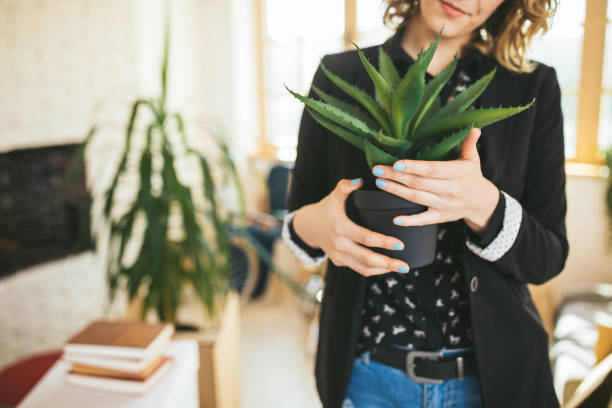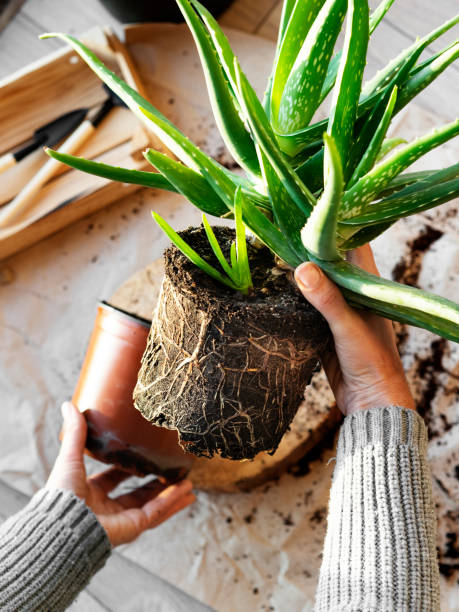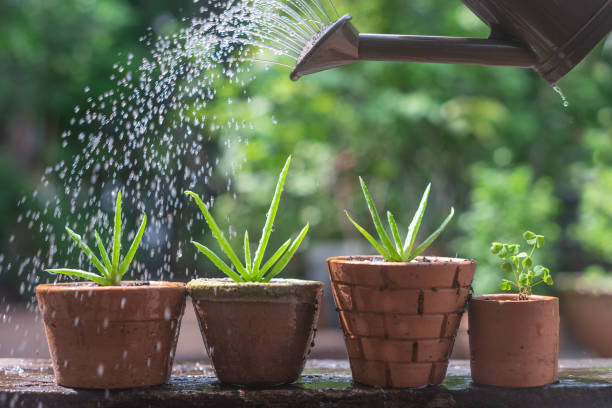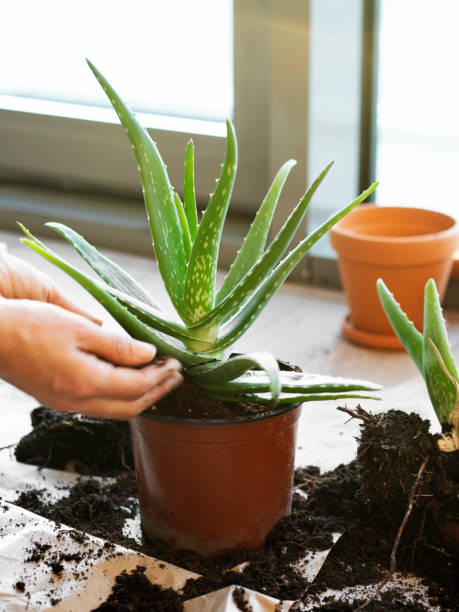
Are you looking for a low-maintenance, yet stunning plant to add to your home or garden? Look no further than the aloe vera plant! This succulent is not only beautiful, but it also has numerous health benefits. Aloe vera plants are easy to care for, but they do have specific needs that you should be aware of in order to keep them healthy and thriving. In this blog post, we will cover some essential tips and tricks for aloe vera plant care.
Choosing the Right Location
The first step in caring for your aloe vera plant is choosing the right location. Aloe vera plants need a lot of sunlight to grow, but they can also be sensitive to extreme heat and direct sunlight. Place your plant in a location that receives bright, indirect sunlight for most of the day. You can also keep it near a window that gets plenty of natural light. Aloe vera plants prefer warm temperatures, so avoid placing them in drafty areas or near air conditioning units. Additionally, it’s important to use well-draining soil and a container with drainage holes to prevent waterlogging.
Watering and Feeding
One of the most common mistakes people make with aloe vera plants is overwatering. These plants are adapted to dry environments, so they don’t need a lot of water. Water your aloe vera plant sparingly and wait until the soil is dry before watering again. Overwatering can lead to root rot and other problems. You should also avoid getting water on the leaves, as this can cause them to rot.
Aloe Vera Plant Care: Tips and Tricks for Healthy and Beautiful Succulents

Are you looking for a low-maintenance, yet stunning plant to add to your home or garden? Look no further than the aloe vera plant! This succulent is not only beautiful, but it also has numerous health benefits. Aloe vera plants are easy to care for, but they do have specific needs that you should be aware of in order to keep them healthy and thriving. In this blog post, we will cover some essential tips and tricks for aloe vera plant care.
Choosing the Right Location
Choosing the right location is critical for the health and success of your aloe vera plant. Aloe vera plants require plenty of bright, indirect sunlight to thrive, which means they should be placed near a window that gets a lot of natural light. Ideally, they should receive about six hours of sunlight each day, but be careful not to expose them to direct sunlight for extended periods, as this can scorch their leaves.
In addition to lighting needs, temperature, and humidity also play a role in aloe vera plant care. Aloe vera plants prefer warm temperatures and do not tolerate frost, so it’s important to keep them in a warm environment. They also prefer relatively low humidity levels, so be mindful of the humidity in your home or garden.
Soil requirements are another important factor in choosing the right location for your aloe vera plant. Aloe vera plants need well-draining soil, as they are susceptible to root rot in overly wet conditions. You can either buy a commercial cactus or succulent potting mix or make your own by mixing sand or perlite with regular potting soil.
Lastly, the size and type of pot or container can also affect the health of your aloe vera plant. Choose a container with drainage holes to prevent waterlogging and use a pot that’s slightly larger than the plant’s root ball to allow room for growth.
Overall, choosing the right location for your aloe vera plant requires careful consideration of lighting, temperature, humidity, soil, and container requirements. By providing the ideal growing conditions, you can ensure that your aloe vera plant thrives and adds beauty and health benefits to your home or garden.
Lighting needs
Aloe vera plants require bright, indirect sunlight to grow and thrive. These plants are native to hot and dry regions, where they have adapted to receive plenty of sunlight. However, they can also be sensitive to direct sunlight, so it’s important to find the right balance when it comes to lighting.
Ideally, aloe vera plants should receive at least six hours of bright, indirect sunlight each day. This means they should be placed near a window that gets a lot of natural light. A south-facing window is ideal, but if your home doesn’t have one, you can also place your plant near an east or west-facing window.
If you notice that your aloe vera plant is not getting enough light, it may start to stretch and become leggy. This is a sign that it’s not getting enough sunlight and is reaching for the light source. In this case, you can move your plant to a brighter location or provide additional artificial light using grow lights.
On the other hand, if your aloe vera plant is getting too much direct sunlight, it may become scorched or discolored. If you notice this happening, you can move your plant to a location with more shade or filter the sunlight using a sheer curtain or shade cloth.
Overall, providing the right amount and quality of light is essential for the health and growth of your aloe vera plant. By keeping your plant near a window that gets plenty of natural light, or supplementing with artificial light if necessary, you can help your aloe vera plant thrive and enjoy its many benefits.
Temperature Requirements
Aloe vera plants prefer warm temperatures and do not tolerate frost. They thrive in temperatures between 60 and 75 degrees Fahrenheit (15 to 24 degrees Celsius). While they can tolerate some temperature fluctuations, it’s important to avoid exposing them to extreme temperatures or sudden changes in temperature. Avoid placing your aloe vera plant in drafty areas, as this can cause stress and damage to the plant.
Soil Requirements

Aloe vera plants need well-draining soil to prevent waterlogging and root rot. They prefer a soil that’s slightly acidic with a pH level between 6.0 and 7.0. You can use a commercial cactus or succulent potting mix or make your own by mixing sand or perlite with regular potting soil.
When planting your aloe vera plant, make sure to choose a container with drainage holes to prevent water from sitting in the bottom of the pot. This can cause the soil to become waterlogged, which can lead to root rot and other issues. Make sure to water your plant sparingly and allow the soil to dry out between watering.
If you notice your aloe vera plant is not thriving, it may be due to soil issues. Check the soil to see if it’s too wet or too dry, and adjust your watering schedule accordingly. You can also repot your plant in fresh soil if the soil is compacted or depleted of nutrients.
Overall, providing the right temperature and soil conditions is critical for the health and success of your aloe vera plant. By keeping your plant in a warm environment and using well-draining soil in a container with drainage holes, you can help your aloe vera plant thrive and enjoy its many benefits.
Watering and Feeding

One of the most common mistakes people make with aloe vera plants is overwatering. These plants are adapted to dry environments, so they don’t need a lot of water.
Watering frequency and amount
Water your aloe vera plant sparingly and wait until the soil is dry before watering again. Overwatering can lead to root rot and other problems.
Fertilizer requirements

Aloe vera plants are relatively low-maintenance and do not require a lot of fertilizer to thrive. In fact, over-fertilizing can actually harm the plant, so it’s important to use the right type and amount of fertilizer.
Type of Fertilizer
Aloe vera plants prefer a balanced, water-soluble fertilizer that’s low in nitrogen. Look for a fertilizer with an N-P-K ratio of 10-40-10 or 14-27-14. These ratios ensure that the plant gets enough nutrients without overstimulating growth.
You can also use a cactus or succulent fertilizer, which is specifically formulated for these types of plants. These fertilizers contain the right balance of nutrients to support healthy growth without overstimulating the plant.
Fertilizer Amount and Frequency
When it comes to fertilizing your aloe vera plant, less is more. You should only fertilize your plant once every three months during the growing season, which is typically from spring to fall. In the winter, when the plant is dormant, you can skip fertilization altogether.
You should also avoid over-fertilizing your aloe vera plant. Too much fertilizer can lead to burned leaves or root damage. Always follow the manufacturer’s instructions when applying fertilizer, and do not exceed the recommended dosage.
Alternative Fertilization Methods
In addition to using commercial fertilizers, you can also use natural fertilizers, such as compost or worm castings. These types of fertilizers are gentle and provide slow-release nutrients to the plant.
Another way to naturally fertilize your aloe vera plant is by using the plant’s own cuttings. You can place a cutting in the soil near the base of the plant, which will decompose and release nutrients into the soil.
Overall, fertilizing your aloe vera plant is not necessary, but if you do choose to fertilize, it’s important to use the right type and amount of fertilizer. By providing your plant with balanced nutrients, you can help it thrive and enjoy its many benefits.
Propagation
Propagating aloe vera plants is an easy and cost-effective way to expand your collection or share plants with friends and family. Aloe vera plants can be propagated using offsets or leaf cuttings.
Offsets
Offsets are baby plants that grow at the base of the parent plant. They can be easily removed and transplanted to a new container. To propagate aloe vera plants using offsets, follow these steps:
- Select an offset that is at least a few inches tall and has a healthy root system.
- Gently remove the offset from the parent plant using a sharp, sterile knife or shears.
- Allow the offset to dry for a day or two, which will help the wound callus over.
- Plant the offset in a well-draining soil mixture and water sparingly until it begins to root and establish itself.
Leaf Cuttings
Leaf cuttings are another method of propagating aloe vera plants. To propagate using leaf cuttings, follow these steps:
- Select a healthy, mature leaf from the parent plant.
- Cut the leaf at the base using a sharp, sterile knife.
- Allow the cut end to dry for a day or two, which will help it callus over.
- Plant the cutting in a well-draining soil mixture, burying the cut end about an inch deep.
- Water sparingly and wait for the cutting to root and establish itself.
Tips for Propagation
When propagating aloe vera plants, it’s important to be patient and gentle. Avoid overwatering or over-fertilizing, as this can harm the developing plants. It’s also important to use a well-draining soil mixture and avoid letting the soil become waterlogged.
In general, propagating aloe vera plants is a simple and rewarding process that can help you expand your collection and share plants with others. By following the steps above, you can successfully propagate your aloe vera plant and enjoy its many benefits for years to come.
Common Problems and Solutions
Despite their hardiness, aloe vera plants can still experience problems from time to time. Here are some of the most common problems that aloe vera plants face and how to solve them.
Overwatering
Overwatering is one of the most common problems that aloe vera plants face. When the soil is too wet, the plant’s roots can rot, causing the plant to wilt and die. To solve this problem, reduce the frequency of watering and allow the soil to dry out completely between waterings. You can also repot the plant in a well-draining soil mixture and make sure the container has drainage holes to prevent water from accumulating.
Underwatering
Underwatering can also be a problem for aloe vera plants. When the soil is too dry, the plant’s leaves can become brown and crispy. To solve this problem, water the plant thoroughly, and make sure the soil is evenly moist. You can also mist the plant with water to increase humidity and help it retain moisture.
Pests
Aloe vera plants can be susceptible to pests, such as mealybugs and spider mites. These pests can cause damage to the leaves and stem, and even kill the plant if left untreated. To solve this problem, gently wash the plant with a solution of water and dish soap, or use an insecticidal soap or oil to treat the plant.
Sunburn
Aloe vera plants can also suffer from sunburn if they are exposed to too much direct sunlight. The leaves can become discolored or scorched, and the plant can become stressed. To solve this problem, move the plant to a shadier location, or filter the sunlight using a sheer curtain or shade cloth.
Root Rot
Root rot can occur when the soil is too wet, causing the plant’s roots to rot and die. To solve this problem, reduce the frequency of watering and allow the soil to dry out between waterings. You can also repot the plant in a well-draining soil mixture and make sure the container has drainage holes to prevent water from accumulating.
Overall, aloe vera plants are relatively low-maintenance and can thrive in a variety of conditions. By addressing common problems and providing the right growing conditions, you can help your aloe vera plant stay healthy and beautiful for years to come.
Pest and disease prevention
Aloe vera plants can be susceptible to mealybugs and other pests. It’s important to regularly inspect your plant and treat any infestations promptly.
Conclusion
In conclusion, aloe vera plants are a beautiful and low-maintenance addition to any home or garden. With the proper care and attention, they can thrive for years to come. Use the tips and tricks in this blog post to keep your aloe vera plant healthy and beautiful.





